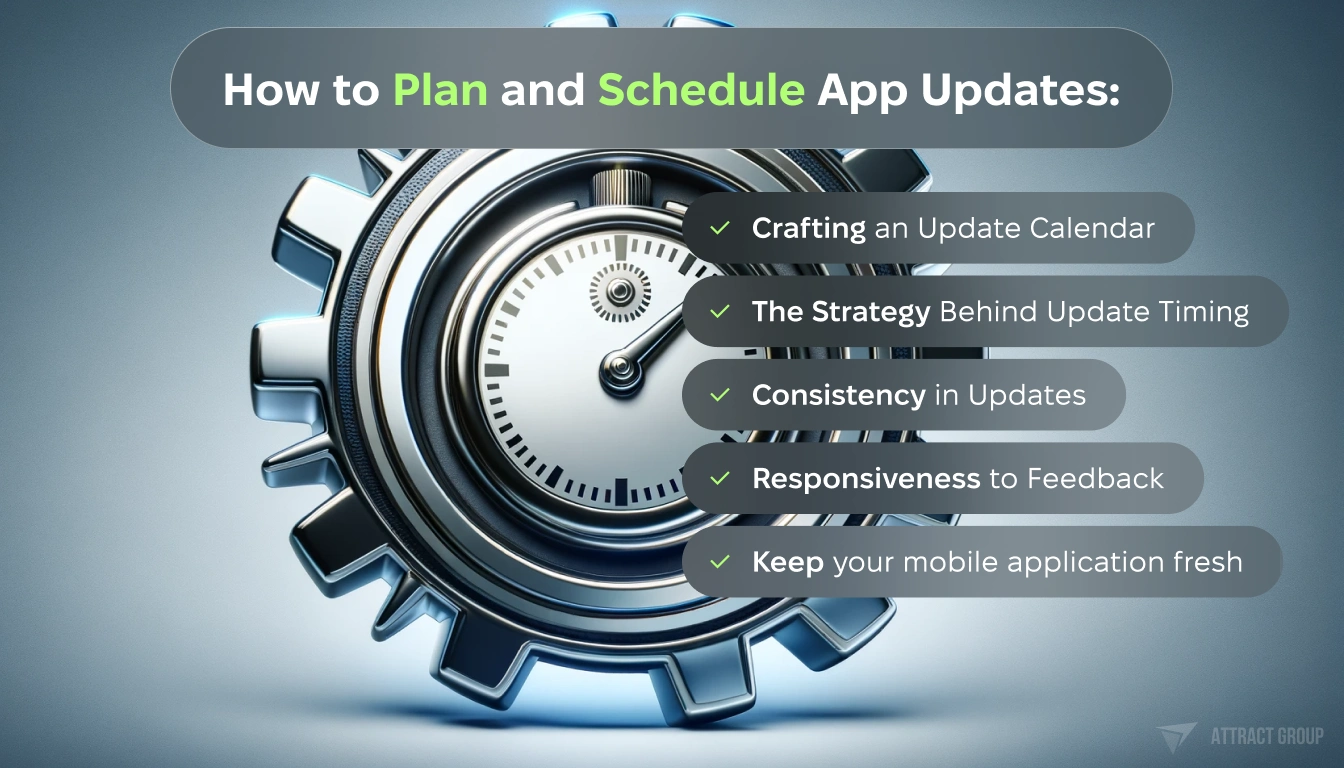Keeping Your App Fresh: The Importance of Regular Mobile App Updates
 20 November 2023
20 November 2023In an era where mobile applications are ubiquitous, the phrase ‘adapt or perish’ has never been more apt. Regular mobile app updates are not just a technical nicety but a fundamental necessity. They serve as the pulse that keeps the app vibrant, secure, and aligned with user expectations. By continuously refining the mobile app through updates, developers can ensure their creation thrives in the competitive ecosystems of Google Play and the App Store.
Statistics show that average app retention rates are 75% higher in developed countries, underscoring the impact of updates on user engagement.
This article delves into the myriad benefits that regular updates confer upon users and developers, from introducing new features that enhance user experience to leveraging analytics for improved performance. As we unpack the lifecycle of a mobile app post-launch, the importance of update-driven evolution becomes undeniably clear.
The Lifecycle of a Mobile App
Post-launch, a mobile app enters a critical phase of its existence. The journey from its debut on platforms like Google Play Store or the App Store to becoming a staple on a user’s device is marked by continuous improvement and iteration. This is where the monitoring, feedback, and updating phases become pivotal.

Monitoring for Momentum
Analytics plays a crucial role here. Developers must keep a keen eye on how users interact with their apps. Key performance metrics provide invaluable insights into what works and what doesn’t, shaping the roadmap for future updates.
Feedback as a Beacon
User feedback is the compass that guides the mobile app development process. It’s essential to listen to the users, understand their needs, and adapt accordingly. Regular updates allow developers to respond to this feedback on time, showing users their voices are heard and valued.
Updating as Evolution
The update phase is where the app evolves. It’s an ongoing process of enhancement, refinement, and, sometimes, significant transformation. Whether introducing in-app purchases, deploying a new feature, or improving existing functionalities, each update is a step toward perfection.
User Expectations and App Evolution
The mobile app market thrives on user satisfaction, where the expectation is not just to work but to dazzle. With users installing an average of 40 apps on their mobile devices, each app must fight to maintain its relevance and presence. However, updates play a pivotal role in this battle for attention. Industry insights reveal that apps updated regularly can see user retention rates increase fourfold compared to those updated less frequently.
The Statistical Edge of Regular Updates
A statistical glance underscores the importance of update frequency:
| Update Type | User Retention Increase | User Satisfaction Rate |
| Frequent Updates | 4x | 75% |
| Infrequent Updates | 1x | 30% |
The Symbiosis of Updates and Operating Systems
Operating systems like Android and iOS undergo continual evolution, and apps must follow suit to ensure compatibility. Regular app maintenance and updates allow apps to function optimally on the latest versions, thus preventing any errors.
Balancing Update Frequency with Quality
While app users often query, “How often should you update your app?” there’s no one-size-fits-all answer. The recommended update schedule hinges on several factors, including user feedback and quantitative data from app analytics. A prudent update release strategy balances the introduction of new features with the enhancement of the existing user experience.
The Competitive Advantage of App Updates
App development companies typically suggest an update cycle of every 4-6 weeks. This strategy is not just about bug fixing but also about adapting to user feedback, improving performance, and ensuring the app’s compatibility with the latest device standards.

Regulatory Compliance and App Updates
With frequent changes to Google and Apple’s terms and conditions, apps must be updated promptly to remain compliant. Failing to do so can lead to operational issues or removal from app stores.
However, regular updates are a commitment to the user that their app will continue to evolve. They are necessary for any app that aims to keep its place on a user’s device in the competitive mobile app market.
Enhancing Security through Updates
Keeping your mobile app secure is a necessity. With each update, you fortify your app against the latest security threats. Don’t let your guard down—regular updates are your shield against vulnerabilities that could compromise user data. Take action now; update your app and safeguard your users’ trust.
Takeaways:
- Update Now: Don’t wait for a breach; secure your app today with the latest updates.
- Stay Informed: Regularly check for updates available and stay ahead of threats.
- Engage with Expertise: Consider partnering with a mobile app development company that prioritizes security.
- Share the Knowledge: Inform your users about the benefits of updating apps; encourage them to download the latest version always.
By staying vigilant and proactive, you ensure your mobile application remains a trusted tool for users. Make the smart choice—update regularly and maintain peace of mind.
Improving User Experience and Engagement
Enhancements through mobile app updates are a powerful way to boost user experience and keep your audience engaged. Every new feature update should aim to make using the app smoother and more enjoyable. Listen to your users—they are the compass that guides the development of your application. With each update, strive to refine their journey and make each interaction with your app a delight.
So, regularly refresh your app with the latest release updates that respond to user feedback and enhance the user experience. This not only pleases your current users but also attracts new ones.
Remember, an engaged user is a loyal user. By committing to regular, user-focused updates, you solidify the relationship between your app and its users. Update your mobile app today and watch your engagement levels soar.
Leveraging Mobile App Updates for Competitive Advantage
Regular app updates are strategic moves in the competitive app marketplace. Data shows that 70% of users will abandon an app if it takes too long to load, and dissatisfaction persists after a 3-second delay.

However, in App Store Optimization (ASO), description updates and refreshed app icons play a significant role, with 46% and 30% of developers, respectively, using these methods to boost their app’s visibility. These updates contribute to the substantial yearly growth in global spending across app stores, which hit $112 billion, underscoring the lucrative potential of frequent and thoughtful updates.
So, implement strategic updates that refine user experience and contribute to ASO, directly influencing your app’s success in the market.
By focusing on these updates, app publishers can not only meet user expectations but exceed them, turning each update into an opportunity for growth and a stronger market position.
The Technical Side of Mobile Application Updates
Delving into the technical side of mobile app updates reveals a complex process that balances innovation with precision. For app developers, rolling out an update is a multi-stage operation that involves careful planning and rigorous testing. It’s not just about the frequency of updates but their impact and stability.
- Mastering the Update Process: Each update, whether it’s for an Android app or an iOS application, must navigate the specific guidelines of Google Play or the Apple App Store. Mobile app development companies must manage app maintenance with an eye on the ever-changing standards set by these platforms.
- Overcoming Update Challenges: The path to a successful update release is often challenging. These can range from ensuring backward compatibility with older versions of operating systems to adapting to the different hardware specifications of a myriad of mobile devices.
- Adopting Best Practices: To mitigate these challenges, app owners are encouraged to adopt best practices such as using automated testing tools, adhering to agile development methodologies, and collecting quantitative data to inform decisions. Bug fixing updates must be thorough yet swift to maintain user trust.
- Stay Updated: Keep your app at the forefront of innovation and security. Regular updates are not just recommended; they are essential. Update your mobile application today and stay ahead in the competitive mobile app market.
By following these technical best practices and facing update challenges head-on, developers can ensure that the app maintenance process is as efficient as possible, leading to a smooth and successful update release.

The Impact of Not Updating
Neglecting to update your mobile application can lead to a swift decline in user engagement and satisfaction. An outdated app risks not only security breaches but also a tarnished reputation in the competitive mobile app market.
So, frequent and relevant updates are essential; they keep your app in line with the latest operating systems and technologies. Failing to do so can result in a loss of user trust and, ultimately, a decrease in your active user base.
Don’t let your app fall behind—ensure regular updates to maintain its vitality and relevance. A single update can rejuvenate your app and re-engage users, keeping your app’s ratings high and your users happy. Make updating a priority, and watch your app thrive.
How to Plan and Schedule App Updates
Here’s how you can plan and schedule your app updates to make them work efficiently:
- Crafting an Update Calendar
Timing is everything regarding app updates. A well-planned update calendar aligns with user expectations and market demands. Strategize your update frequency—bi-weekly, monthly, or quarterly—to keep your app’s performance at its peak. Remember, regular updates signal ongoing improvement and reliability to your users.
- The Strategy Behind Update Timing
Scheduling updates requires a balance. You must consider the app development company’s capacity, the app’s complexity, and the user’s convenience. The goal is to minimize disruption while maximizing the app’s value with new features or necessary bug fixes. Aim to release during off-peak hours to ensure the least impact on user experience.
- Consistency in Updates
Maintaining a consistent schedule is key. Users and app stores alike appreciate predictability. Consistency helps with user retention and boosts your rankings in the app store and Google Play algorithms, making your app more discoverable to potential new users.
- Responsiveness to Feedback
Beyond a set schedule, be prepared to roll out unscheduled updates in response to critical feedback or unforeseen issues. Agile response times can turn potential negative reviews into positive user experiences.
- Your Next Steps
Plan your update schedule with user needs at the forefront. Keep your mobile application fresh, functional, and ahead of the curve. Regular updates are not just maintenance; they are an integral part of your app’s growth and user satisfaction. Stay proactive, stay relevant, and keep your app updated.

Measuring the Success of Updates
To gauge the impact of your updates, closely monitor key performance indicators (KPIs) post-release. User feedback, app store ratings, and engagement metrics provide a quantitative look at the update’s success. Look for trends in user retention and acquisition, and pay attention to how new features are used.
These insights will inform your future updates, ensuring each one delivers value to your users and keeps your app competitive. Always strive to translate data into actionable improvements, keeping your app’s evolution user-centric and data-driven.
App Store Optimization (ASO) and Updates
Regular updates can significantly enhance your App Store Optimization (ASO) efforts. Each update presents a chance to refine keywords, tweak your app’s description, and showcase new features—all of which can improve your app’s visibility in in-store searches.
Moreover, updates reflect an active commitment to your app, which both users and app store algorithms favor. Stay ahead of the curve by aligning your update strategy with ASO best practices to maximize discoverability and drive downloads. Keep your app relevant, secure, and high-ranking with thoughtful, regular updates.
Cost Considerations of Regular Updates
Frequent updates invest in the app’s longevity but come with associated costs. Developers must budget for the app development lifecycle, which includes the design, testing, and deployment of each update.
A cost-benefit analysis can help decide the optimal update frequency, ensuring the value added to the user experience justifies the expense. Consider long-term savings as well; regular maintenance can reduce the need for more costly overhauls in the future. Invest wisely in your app’s updates to maintain a competitive edge without compromising your bottom line.
Conclusion
In conclusion, regular mobile app updates are a fundamental component of a successful app strategy. They keep the app secure, functional, and aligned with user expectations, fostering a positive and engaging user experience.
Developers must balance the demands of frequent updates with the associated costs, ensuring each update delivers tangible benefits to both the user and the app’s performance.
By planning a consistent update schedule, responding to user feedback, and optimizing for the app stores, developers can maintain the vitality and relevance of their app in a competitive market. Embrace the update process as an opportunity for growth and improvement, and watch your app thrive.










